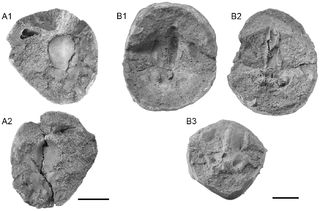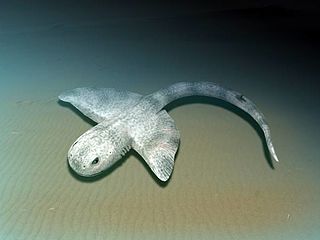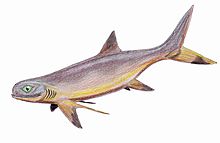
Chondrichthyes is a class of jawed fish that contains the cartilaginous fish or chondrichthyians, which all have skeletons primarily composed of cartilage. They can be contrasted with the Osteichthyes or bony fish, which have skeletons primarily composed of bone tissue. Chondrichthyes are aquatic vertebrates with paired fins, paired nares, placoid scales, conus arteriosus in the heart, and a lack of opecula and swim bladders. Within the infraphylum Gnathostomata, cartilaginous fishes are distinct from all other jawed vertebrates.

Holocephali, sometimes given the term Euchondrocephali, is a subclass of cartilaginous fish in the class Chondrichthyes. The earliest fossils are of teeth and come from the Devonian period. Little is known about these primitive forms, and the only surviving group in the subclass is the order Chimaeriformes.

Cladoselache is an extinct genus of shark-like chondrichthyan from the Late Devonian (Famennian) of North America. It was similar in body shape to modern lamnid sharks, but was not closely related to lamnids or to any other modern (selachian) shark. As an early chondrichthyan, it had yet to evolve traits of modern sharks such as accelerated tooth replacement, a loose jaw suspension, enameloid teeth, and possibly claspers.

Stethacanthus is an extinct genus of shark-like holocephalians which lived from the Late Devonian to Late Carboniferous epoch, dying out around 298.9 million years ago. Fossils have been found in Australia, Asia, Europe and North America.

Xenacanthida is a super-order of extinct shark-like chondrichthyans known from the Carboniferous to Triassic. They were native to freshwater, marginal marine and shallow marine habitats. Some xenacanths may have grown to lengths of 5 m (16 ft). Most xenacanths died out at the end of the Permian in the End-Permian Mass Extinction, with only a few forms surviving into the Triassic.

Hybodus is an extinct genus of hybodont, a group of shark-like elasmobranchs that lived from the Late Devonian to the end of the Cretaceous. Species closely related to the type species Hybodus reticulatus lived during the Early Jurassic epoch. Numerous species have been assigned to Hybodus spanning a large period of time, and it is currently considered a wastebasket taxon that is 'broadly polyphyletic' and requires reexamination. The first fossilized teeth from Hybodus were found in England around 1845; since then teeth have been recovered from Europe. During the Triassic, Jurassic, and Cretaceous periods, the hybodonts were especially successful and could be found in shallow seas around the world. For reasons that are not fully understood, the hybodonts became extinct near the end of the Late Cretaceous period.

The Bear Gulch Limestone is a limestone-rich geological lens in central Montana, renowned for the quality of its late Mississippian-aged fossils. It is exposed over a number of outcrops northeast of the Big Snowy Mountains, and is often considered a component of the more widespread Heath Formation. The Bear Gulch Limestone reconstructs a diverse, though isolated, marine ecosystem which developed near the end of the Serpukhovian age. It is a lagerstätte, a particular type of rock unit with exceptional fossil preservation of both articulated skeletons and soft tissues. Bear Gulch fossils include a variety of fish, invertebrates, and algae occupying a number of different habitats within a preserved shallow bay.

Falcatus is an extinct genus of falcatid chondrichthyan which lived during the early Carboniferous Period in Bear Gulch bay in what is now Montana.

Stethacanthidae is an extinct family of prehistoric holocephalians. It is estimated to have existed approximately between 380 and 300 million years ago. Members of this family are noted for their peculiar dorsal fin.

Symmorium is a dubious genus of extinct stethacanthid holocephalian from the Devonian and Carboniferous of the United States (Illinois) and Russia. The type species, Symmorium reniforme, was named by Edward Drinker Cope in 1893 and several other species were originally classed under this genus, but they have since been classified into other genera such as Petalodus. Symmorium bears close similarity in size and appearance to Stethacanthus but the former is missing the "spine and brush" on its back. Some paleontologists think that the two forms are simply the males and females of related species, while other scientists think they were distinct genera.

Falcatidae is a family of Paleozoic holocephalians. Members of this family include Falcatus, a small fish from the Bear Gulch Limestone of Montana. The family first appeared around the start of the Carboniferous, and there is some evidence that they survived well into the early Cretaceous, though its putative Cretaceous members were also argued to be more likely neoselachians.

Hybodontiformes, commonly called hybodonts, are an extinct group of shark-like chondrichthyans, which existed from the late Devonian to the Late Cretaceous. They form the group of Elasmobranchii closest to neoselachians, the clade of modern sharks and rays. Hybodonts were named and are distinguished based on their conical tooth shape. They are also noted for the presence of a spine on each of their two dorsal fins. They were abundant in marine and freshwater environments during the late Paleozoic and early Mesozoic, but were rare in open marine environments by the end of the Jurassic, having been largely replaced by modern sharks, though they were still common in freshwater and marginal marine habitats. They survived until the end of the Cretaceous, before going extinct.

Kawichthys was an extinct genus of symmoriiform cartilaginous fish from Upper Pennsylvanian deposits of Kansas, United States. Kawichthys is known from two well preserved three-dimensional neurocrania: the holotype KUVP 152144 is associated with some disturbed and broken postcranial elements, but the braincase is partially crushed, and the paratype KUVP 56340. It was collected from the Douglas Group, between the Haskell Limestone and the lower beds of the overlying Robbins Shale, previously classified as members of the Lawrence Formation or Stranger Formation, but now recognized as members of the extension of the Cass Limestone classification into Kansas. It was first named by Alan Pradel, Paul Tafforeau, John G. Maisey and Philippe Janvier in 2011 and the type species is Kawichthys moodiei.
This list of fossil fishes described in 2017 is a list of new taxa of jawless vertebrates, placoderms, acanthodians, fossil cartilaginous fishes, bony fishes and other fishes of every kind that are scheduled to be described during the year 2017, as well as other significant discoveries and events related to paleontology of fishes that are scheduled to occur in the year 2017. The list only includes taxa at the level of genus or species.
Dwykaselachus is an extinct genus of symmoriiform, a cartilaginous fish that lived in what is now South Africa during the Permian period around 280 million years ago. It was first discovered in the 1980s, in a nodule of sediments from the Karoo Supergroup. Dwykaselachus was named based on Dwyka Group, the group of sedimentary geological formation in the southeastern part of Africa. It represents the place where the type species Dwykaselachus oosthuizeni was found.
Ozarcus is an extinct genus of symmoriiform from the Carboniferous period of Arkansas. The type species, Ozarcus mapesae, was named in 2014 based on cartilaginous skulls from the Serpukhovian-age Fayetteville Formation. The genus is named after the Ozark Mountains while the species was named after its discoverer, G. K. Mapes.

Ctenacanthiformes is an extinct order of elasmobranch fish. They possessed ornamented fin spines at the front of their dorsal fins and cladodont-type dentition, that is typically of a grasping morphology, though some taxa developed cutting and gouging tooth morphologies. Some ctenacanths are thought to have reached sizes comparable to the great white shark, with body lengths of up to 7 metres (23 ft) and weights of 1,500–2,500 kilograms (3,300–5,500 lb). Ctenacanths are typically thought to have existed from the Devonian to the Late Permian, becoming extinct in the Permian-Triassic extinction event. Members of the family Ctenacanthidae may have survived into the Cretaceous based on teeth found in deep water deposits of Valanginian age in France and Austria, however, other authors contend that the similarity of these teeth to Paleozoic ctenacanths is only superficial, and they likely belong to neoselachians instead. The monophyly of the group has been questioned, with some studies recovering the group as a whole as paraphyletic or polyphyletic.

Cretacladoides is a genus of chondrichthyan, possibly a falcatid, found in France and Austria. Known solely from teeth, mainly found in the Klausrieglerbach locality of Austria, it consists of two species, C. ogiveformis and C. noricum. Assuming a falcatid identity, it is the most recent member of the family, which otherwise became extinct at the end of the Carboniferous.

Dracopristis is an extinct genus of ctenacanth that lived around 307 million years ago, during the Pennsylvanian sub-period of the Carboniferous period. The fish had 12 rows of short, squat teeth, and an array of spines on its dorsal fins. The main differentiation between ctenacanthiformes and true sharks is that ctenacanthiform mouths are larger but less flexible than the true sharks. The spines of the holotype fossil are about 0.57 meters long, and the whole body was around 2 meters (6 ft) long.

Squatinactis is a genus of extinct elasmobranch Chondrichthyes known from the Carboniferous aged Bear Gulch Limestone in Montana. This fish was discovered in 1974 by Richard Lund. The type specimen, named CMNH 46133, consists of a brain case, poorly preserved jaws and gills, a pectoral fin, and a partial vertebral axis. This creatures most startling feature were its broad pectoral fins which resembled those of stingrays and angel sharks (Squatina). The holotype specimen has about 15 teeth in its jaw. This creature is named after the angel shark. Remains found in the South Urals of Russia and the Eyam Limestone of Derbyshire, England, have been tentatively identified as those belonging to S. caudispinatus.






















